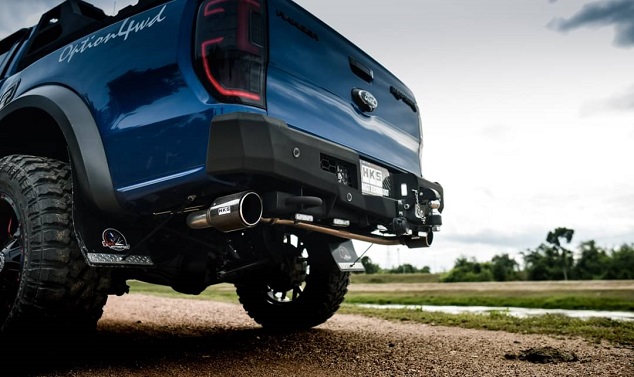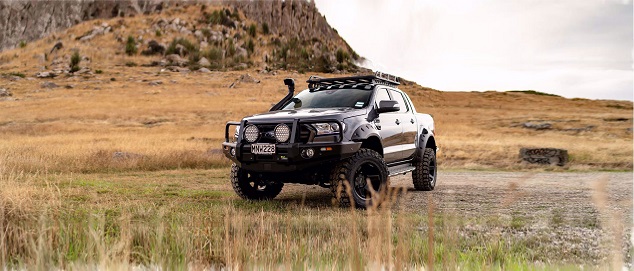Contents
Ford’s Aussie-designed Ranger has been a mid-sized staple of city streets and outback trails for more than a decade. It’s a solid, sensible platform that carries itself well in any setting, so it’s understandable that the much-loved PJ / PK model Rangers, along with their counterpart from Mazda, the BT-50, continue to be Australia’s favourite, and overall best-selling breed of 4X4s.
PJ / PK and BT-50 owners have learned to appreciate how feisty their turbocharged, 3.0L V6 diesels are compared to the powerplants typically found in their larger, less parking-friendly peers. With an easy 115kW / 380Nm on demand, up to a 1,175kg payload tray and 3,038kg towing capacity depending on the package, they do not slouch when it comes to pulling power.
As capable as they are though, an exhaust upgrade can persuade these 3.0L turbos to perform even better. If you happen to own one these mighty, mid-sized 4x4s, an exhaust upgrade isn’t going to make your engine any more powerful, but it is the way to uncork some of the power that the factory exhaust is holding back. And that’s a difference you’re going to notice immediately.
The 3” Ranger Exhaust Upgrade
When it comes to any type of upgrade that’ll put more power on the road, exhaust upgrades easily deliver the biggest benefit for the money. In fact, by simply upgrading the 2″ factory exhaust Ford Ranger and Mazda BT-50 are equipped with to a 3″ system, you can immediately expect as much as 12kW more power on the high end and 50Nm more torque going through the wheels. These would be pretty impressive gains all by themselves, but a correctly tuned aftermarket exhaust is going to do something even more beneficial: it’s going to move heat away from the engine. The more heat you can keep away from your engine and the exhaust gas temperature (EGT) sensor, the better, so upgrading your exhaust is going to improve both exhaust flow and heat evacuation.

Which Parts Make Up an Upgrade
It’s only fitting that an Australian-made exhaust system would be the best option for either of these utes from down under, and you can have a complete turbo back system delivered to you anywhere in the country consisting of 409 stainless steel primary pipe sections that are:
- Mandrel bent to improve exhaust velocity;
- Precision welded inside and out to increase strength and prevent leaks; and,
- Enamel coated to increase heat dispersion.
These systems are designed to be a direct replacement for OE 3.0L BT-50 and Ford Ranger exhaust systems, regardless of the body style or transmission type. Beyond just pipes though, these systems also include:
- High flow, diesel-specific catalytic converters;
- Double braided flex joints; and,
- Resonator and muffler assemblies that are baffled to deliver the perfect pitch.
The truth is, there’s no shortage of turbo and ECU tuning tricks that you can do to these durable little utes, but an exhaust upgrade is a straightforward performance enhancement that doesn’t require any special software or expertise, and you don’t have to spend big money to get big results. If you’re still not convinced about the merits of making a BT-50 or Ford Ranger exhaust upgrade though, then it’s worth considering precisely what an exhaust system’s required to do, and how upgrades allow them to accomplish that.
How Exhaust Systems Work
It’s easy to dismiss just how complicated exhaust systems really are. Every twist, bend, and joint in an exhaust system is designed to facilitate an efficient purpose. And when you consider the engineering that goes into designing a factory system, it becomes clear just how much technical know-how is needed to engineer an aftermarket system that’ll outperform a factory setup. There are 3 forces continuously at work inside every exhaust system.
- Scavenging. The vacuum that’s naturally created by an engine to expel exhaust gases.
- Backpressure. The tendency of exhaust gases to want to resist being expelled.
- Velocity. The speed the exhaust gases reach when they’re being expelled.
The short explanation for how an exhaust system works is that the best possible exhaust gas scavenging has to occur with the least amount of backpressure, and at the highest possible velocity. The irony of factory systems like the standard Mazda and Ranger exhaust is that they’re obliged to strike a balance between optimizing those 3 forces and mandatory fuel economy, emissions control, and noise reduction requirements. In the case of our PJ / PK and BT-50 models, it means that engines with great breathing potential end up being factory restricted by how much they’re allowed to exhale.
What an Upgrade Means for Your Ranger
The PJ / PK and BT-50 family of turbo V6s are tough, reliable engines that can see significant performance gains by simply allowing them to do what they’re already capable of doing. All it takes is switching to an exhaust system that’s designed specifically to:
- Increase exhaust flow and velocity to a maximum;
- Keep backpressure to an absolute minimum; and,
- Disperse as much heat away from the engine as possible.
A 3” Ranger exhaust system upgrade is going to accomplish all of this, and your engine’s going to be under less strain, and will ultimately last longer while delivering better performance.

The Final Word
There’s no doubt about it: both the mild-manner PJ / PK Rangers and BT-50 Mazdas that were designed by Ford Australia is nothing short of impressive. As impressive as they are though, performance-wise, they’ve barely nicked the surface of what they’re capable of producing. Upgrading the factory exhaust Ford Ranger and Mazda BT-50 came equipped with a freer flowing system is going to produce the kind of results that’ll leave you feeling like you’re behind the wheel of a completely different vehicle. You won’t be, though. It’ll still be your same reliable ute: it’ll just be doing what it’s been itching to do for you the entire time.




Comments are closed.